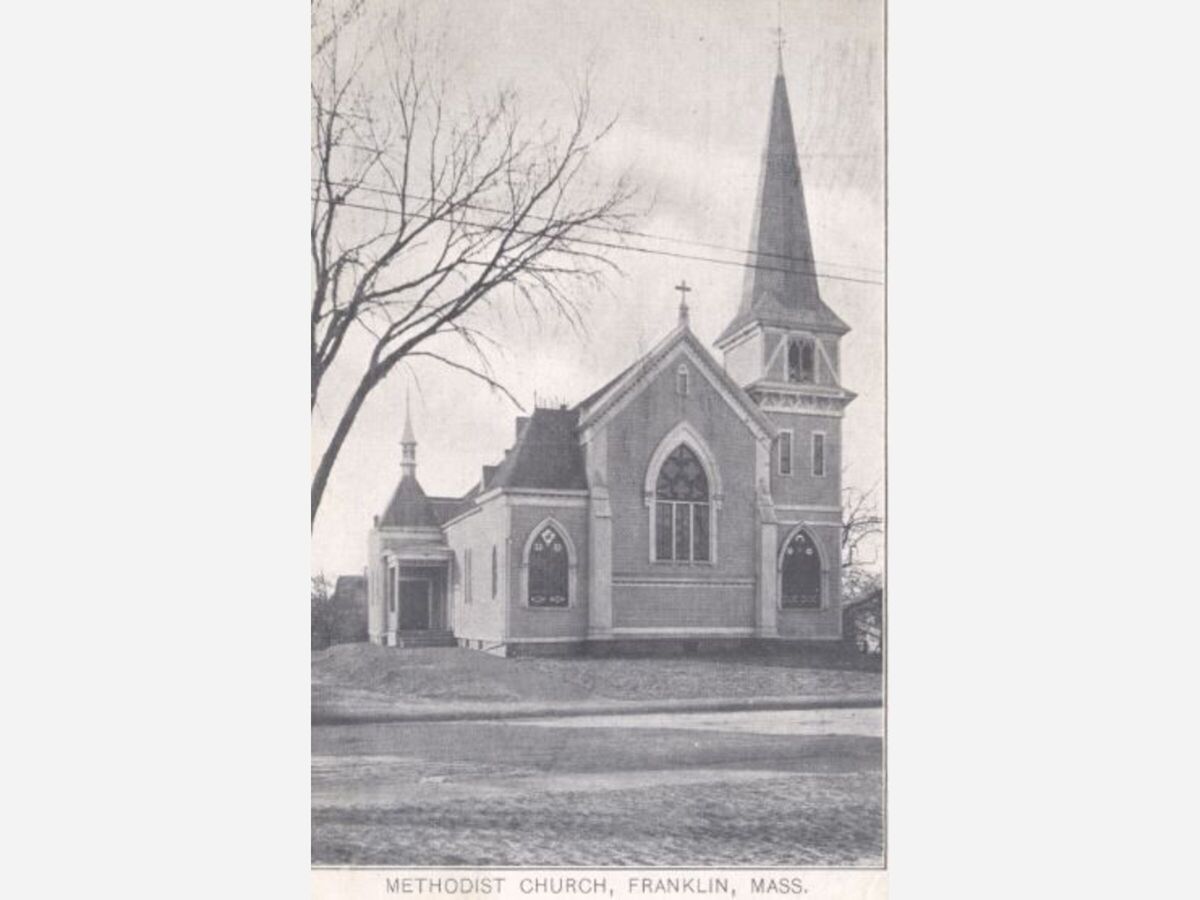Image


Only a generation after the reign of Congregationalist Minister, Nathaneal Emmons, religious diversity at mid-19th century was still a fledgling in Franklin. One of the newcomers was the Methodist denomination. And, a cornerstone laid in 1872 means the Methodist church edifice of Franklin will shortly be 150 years old.
Methodism emerged from the teachings of evangelist John Wesley and several other contemporaries in England during the 18th
century. It was cofounded in the nascent United States by Thomas Coke and Francis Asbury. Only a few years before reaching Franklin, Methodism was split by a division between those in south who owned slaves or sanctioned the ownership of slaves, and those who did not.
According to 19th century Franklin historian Mortimer Blake, “the Methodist church in Franklin owes its existence largely to the self-sacrifice and perseverance of Rev. E.P. King. Though not the first Methodist minister who preached in the town, yet he was the first or organize and give permanency to the work.
“In the year 1853, a Methodist meeting was first started in the Town Hall by Rev. John M. Merrill. He came with the intention of building up a church, if possible, and his efforts were attended with considerable success. During the two years that he remained he gathered quite a large congregation. But the work took no very deep root. Only a very few of the congregation were really Methodists, and of course were not specially interested in the founding of a Methodist church. Indeed there seems to have been no attempt at organization.
“In 1855, Rev. Pliny Wood took charge of the work. He remained one year, and kept the work up pretty well during his pastorage, though he found some difficulty in harmonizing the different elements of his congregation. In 1856 Rev. M.P. Webster came into the field, and while he seems to have labored earnestly the difficulties of the work so multiple that he was utterly unable to meet them. Under his supervision the enterprise ran rapidly down, so that the Conference judged it expedient, in 1857, to give up the work.
“But in the spring of 1871, Dr. William R. Clark, then presiding Elder of the Boston District New England Conference, and Rev. William Merrill of West Medway again started a Methodists meeting in the Town Hall. In November of the same year Dr.
“Clark send Rev. John R. Cushing, a theological student in Boston to take charge. He organized a Sunday-school and gathered a good congregation during the few months that he remained. In April, 1872, the new England Conference sent Rev. E.P. King to the town. He aimed from the first to establish a church as soon as possible. On the 9th of September 1872, he organized a church of thirteen members (three men and ten women) and proceeded at once to solicit funds for building a house of worship, of which he laid the cornerstone 3d October, 1872. He pushed the work so rapidly forward that he held services in the chapel of the new building on the second Sunday of March, 1873, and offered the house for dedication 25th June. A noted revival began in March preceding and continued throughout the year. Over two hundred professed conversion, of whom the church swelled its membership to sixty-six and gained a strong hold in the town.
“In April, 1874, after two years of successful work, Mr. King was taken to another field, and Rev. J.N. Short became pastor of the church, which position he held for three years. During that time the church steadily increased in membership and influence, though considerably crippled by the financial embarrassments of the country. In April, 1877, Rev. George W. Hudson became pastor of the church. He reports a membership of 87, a Sunday-school of 12 officers and teachers, and 120 scholars, and church property of $10,000.
Hurd’s history of Norfolk County carries us forward a few more years, noting that Short was succeeded in 1878 by Rev. William Wignall, 1878-79; Rev. O.W. Adams, 1880-81; Rev. A.C. Godfrey 1882’ and Rev. M.D. Hornbeck, commencing in 1883.
The Register, Franklin’s earliest extant newspaper, has little to say on these matters but does record an occasion in 1875 when Rev. Short was noted as having preached a sermon in Rockville (the northern section of Norfolk).
The subsequent decades have seen a steady support for the congregation and a succession of ministers. The current Pastor, Rev. Jacob Juncker, writes, “To the best of my knowledge while Franklin UMC is not the oldest congregation in Franklin, I do believe it is the oldest congregation to never merge, move, or rebuild. Franklin UMC has, from the very beginning, met on W. Central Street.”
And as for that beautiful structure, its featured were noted by a state researcher in 1989, as being Victorian Gothic. “The building is sheathed in clapboard trimmed with narrow cornerboards and rises to a steeply pitched roof. Entries to the church are set in pointed arched openings contained within pavilions at each corner of the building; the western pavilion at the facade rises to a high tower. The facade is dominated by a two-story bay containing a large, pointed, arched window of stained glass. Side elevations are one story in height and have irregularly-spaced pointed arched windows containing stained glass.”
Rev. Juncker admits that other documentation about the long history of the church is lacking. And Franklin is conspicuously absent from the Boston University archive of historical material pertaining to the many Methodists congregations around the state.
No doubt other sources will emerge in time to fill in the story of this historic Franklin congregation.